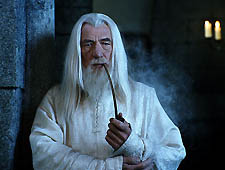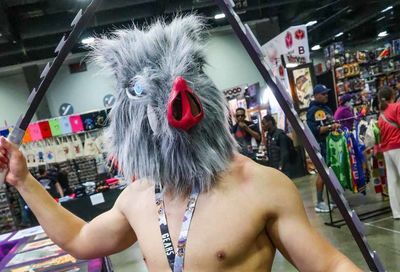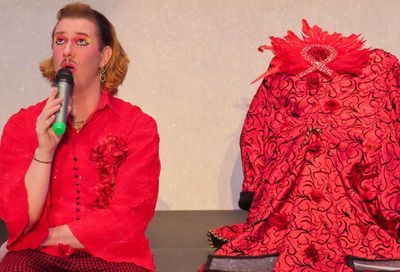Ring Power
Return of the King is a spectacular ending to cinema's greatest achievement
It’s probably a bit premature to call Peter Jackson the greatest filmmaker to have ever lived. It’s not, however, premature to herald the Lord of the Rings trilogy as cinema’s greatest achievement to date. With the third and final chapter, Return of the King, Jackson serves up a sweeping, emotionally charged, visually spectacular conclusion that transports you to another world and grips every last fiber of your being. Put simply: Return of the King is majestic beyond all measure.
 |
Jackson continues to adhere as closely as possible to the J.R.R. Tolkien tome, treating the material with the respect the classic deserves. By making the trilogy on his terms and by not skimping on any detail, great or small (and for that, he’s fortunate that he had a studio willing to take a risk and supply a $300 million-plus budget), Jackson, whose inauspicious early films, the opulent and disturbing Heavenly Creatures and the energized yet fragmented The Frighteners, just barely scraped the surface of this director’s talent, has served both Tolkien’s avid fanbase as well as those who have never read the books.
Despite the elves, dwarves, hobbits, orcs, winged Fell Beasts and other fantastical creatures drawn from the world of myth and magic, Return of the King retains a potent relevance to today’s world. It’s a massive tale of war, of mankind’s attempt to keep evil at bay and take on the mantle of (one can only imagine peaceful) rulership over the fractured society that comprises Middle Earth. It’s a gripping story about doing what’s right, and about the burden of destiny. But most importantly, it’s about friendship, deep and abiding and pure.
 |
The third chapter opens with an unsettling flashback that shows how Sméagol evolved into Gollum, the pitiable ring-obsessed creature now leading the Ring of Power’s bearer, Frodo, and his best friend, Sam, to Mount Doom, where Frodo is to dispose of the cursed ring, thereby destroying Sauron, a great flaming, all-seeing eye, and his minions of horrible, bloodthirsty creatures. Gollum, still tormented by the ring’s power over him, has his own secret plan in mind — and it involves feeding the unsuspecting hobbits to Shelob, a voracious and genuinely terrifying giant spider.
 |
Meanwhile, the Fellowship — Aragorn, Gandalf, Legolas and Gimli — do their part to rally mankind’s remaining troops and save the pristine, white Minas Tirith, the capital of Gondor, from devastation by Sauron’s army. The story contains several mini-adventures involving all of the characters, including hobbits Merry and Pippin, both of whom get a chance to prove their heroic worth.
Jackson relies on the audience’s patience — the first hour of the film builds slowly toward the first heartstopping battle. Similarly, the wrap-up, following an edge-of-the-seat, bracing climax atop the volcanic Mount Doom, is extended epilogue, far longer than what we’re accustomed to in today’s films. It’s usually, slam, bang, we’re done, roll the credits. But Jackson takes his time, fully honoring the path taken by Tolkien in his books (though one imagines extra footage will pop up in the Special Edition DVD when it’s released).
 |
There’s a timeless quality to Return of the King, which incorporates the incredible into a credible environment. Return of the King must keep one foot planted in a foundation of reality, making the magnificent special effects all the more impressive for their seamless integration into the story. An extraordinary amount of detail and care has been put into each and every shot, and many of Jackson’s compositions pay homage to his cinematic forebearers, notably that master forger of epics, David Lean.
The movie’s principal battle sequences make the eye-popping assault on Helm’s Deep in The Two Towers look like a child’s birthday party. The battle of Minas Tirith alone is a heart-pounding exercise in one-upmanship. Just when you think you’ve seen it all, something else comes along — be it a hoard of elephantine Mumakil or a massive onslaught of green-glowing specters — to blow your mind further than you ever thought possible. The spectacle is, at times, a little overwhelming, but it is not for a moment unsatisfying.
 |
There’s romance in Return of the King, but it’s given the short shrift. In fact, the one problem with the series is how little the few female characters have had to do. Return of the King makes some amends in this arena, giving Miranda Otto, who plays Eowyn, tough-willed niece to Theoden (the wonderfully grave Bernard Hill) a brutal and pivotal battle against the all-powerful Witch King Gothmog. It’s a personal, intimate combat that balances out the visual onslaught of the larger battles.
Elijah Wood’s Frodo deepens in this final episode — has there ever been an actor who could do more with two clear blue eyes? — but it becomes clear early on that the centerpiece of the story is Sean Astin’s Sam. Astin rises to the occasion with a tender and forthright performance that touches the heart and stirs the soul. The CGI-generated Gollum — acted and voiced with a thick, sinister glee by Andy Serkis — is even more disquieting in this installment.
|
Ian McKellen continues to astound as the wizard Gandalf and Viggo Mortensen exudes a sense of regal command and fearless courage from every pore as Aragorn, a former ranger who takes to his new role as the future king with a sense of nobility and purpose. And Orlando Bloom, as the fleet elf Legolas (who has a show-stopping encounter with a Mumakil) and John Rhys-Davies as Gilmi the dwarf, bring, respectively, a dash of sparkling swashbuckling and a breath of comic relief to the proceedings. In fact, Gimli has the trilogy’s best line. When the Fellowship is weighing a particularly perilous strategy, one that will help to divert the 10,000 orcs that stand between Frodo and his quest on Mount Doom, the dwarf enthusiastically barks: “Certainty of death. Small chance of success. What are we waiting for? ”
 Return of the King is, by itself, a rich and wondrous experience. Unlike other trilogy finales, it doesn’t disappoint. Rather, it exceeds beyond all possible expectations. It’s the kind of movie that movies were made for.
Support Metro Weekly’s Journalism
These are challenging times for news organizations. And yet it’s crucial we stay active and provide vital resources and information to both our local readers and the world. So won’t you please take a moment and consider supporting Metro Weekly with a membership? For as little as $5 a month, you can help ensure Metro Weekly magazine and MetroWeekly.com remain free, viable resources as we provide the best, most diverse, culturally-resonant LGBTQ coverage in both the D.C. region and around the world. Memberships come with exclusive perks and discounts, your own personal digital delivery of each week’s magazine (and an archive), access to our Member's Lounge when it launches this fall, and exclusive members-only items like Metro Weekly Membership Mugs and Tote Bags! Check out all our membership levels here and please join us today!




















